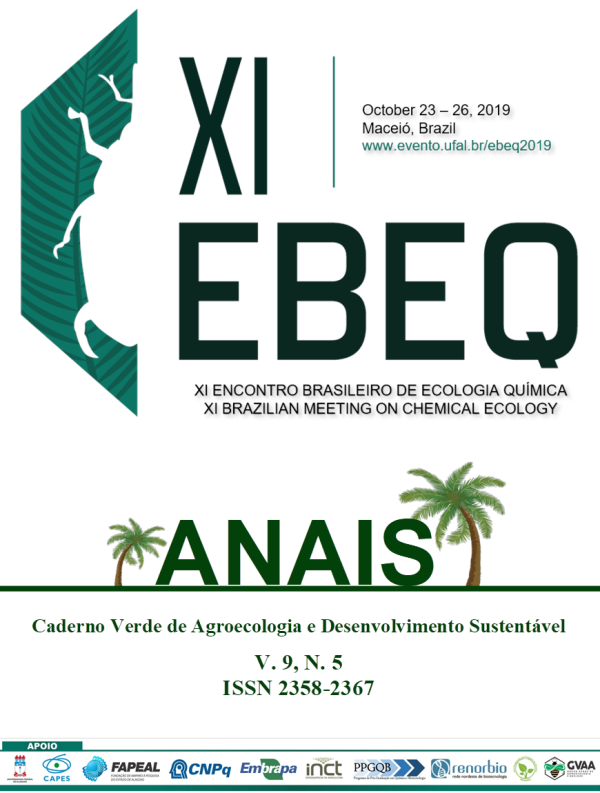ANTIFEEDANCY AND OLFACTORY RESPONSE OF HORN FLIES TO LOLINE ALKALOIDS FROM TALL FESCUE-Neotyphodium coenophialum SYMBIOSIS
Palavras-chave:
HORN FLY, LOLINE ALKALOIDS, ANTIFEEDANCY, REPELLENCYResumo
The horn fly, Haematobia irritans, is an obligate bloodsucking ectoparasite of cattle and is the major global pest of livestock production. Currently, management of H. irritans is achieved using broad-spectrum insecticides. Although, because of the development of resistance, alternative control methods are necessary. Over the last decade, grasses symbioses with endophytic fungi has been studied as a control alternative, due to the grass-endophyte capability to biosynthesize alkaloids. Lately we described an indirect insecticidal effect upon H. irritans when cattle grazing on Tall Fescue pasture Neotyphodium coenophialum infected. Also, we demonstrated that peramine and lolitrem B from N. coenophialum were transferred to cattle dung, producing an insecticidal effect on larvae and pupae. It is well-known that peramine and loline alkaloids have been associated with potent effects on insects and low toxicity to grazing animals. However, information about the effect of loline alkaloids on adult flies is scarce. Here, we evaluated the antifeedancy and repellency of loline alkaloids obtained from N. coenophialum-infected Tall Fescue (E+). Horn flies were collected from steers fed on endophyte-free tall fescue pasture. The alkaloid extract (EALK) from Tall Fescue (E+) was obtained by acid-base extraction. N-acetyl loline/N-formyl loline mixture was obtained from EALK by pTLC and, loline was prepared by acid hydrolysis of lolines mixture. Lolines identification was performance by GC/MS. Feeding behaviour of horn flies was tested according to Zhu et al (2015), and olfactory response was evaluated using a Y-tube olfactometer. Accordingly, EALK and loline reduced horn fly feeding at 500 mg L-1 and greater. NAL/NFL mixture reduced horn fly feeding at all doses evaluated and, EALK and NAL/NFL mixture exhibited spatial repellency in the olfactometer. Thus, loline alkaloids might be useful for adult horn fly control.Downloads
Publicado
Como Citar
Edição
Seção
Licença
Termo de cessão de direitos autorias
Esta é uma revista de acesso livre, em que, utiliza o termo de cessão seguindo a lei nº 9.610/1998, que altera, atualiza e consolida a legislação sobre direitos autorais no Brasil.
O(s) autor(es) doravante designado(s) CEDENTE, por meio desta, publica a OBRA no Caderno Verde de Agroecologia e Desenvolvimento Sustentável, representada pelo Grupo Verde de Agroecologia e Abelhas (GVAA), estabelecida na Rua Vicente Alves da Silva, 101, Bairro Petrópolis, Cidade de Pombal, Paraíba, Brasil. Caixa Postal 54 CEP 58840-000 doravante designada CESSIONÁRIA, nas condições descritas a seguir:
O CEDENTE declara que é (são) autor(es) e titular(es) da propriedade dos direitos autorais da OBRA submetida.
O CEDENTE declara que a OBRA não infringe direitos autorais e/ou outros direitos de propriedade de terceiros, que a divulgação de imagens (caso as mesmas existam) foi autorizada e que assume integral responsabilidade moral e/ou patrimonial, pelo seu conteúdo, perante terceiros.
O CEDENTE mantêm os direitos autorais e concedem à revista o direito de divulgação da OBRA, com o trabalho simultaneamente licenciado sob a Licença Creative Commons do tipo atribuição CC-BY.
O CEDENTE têm autorização para distribuição não-exclusiva da versão do trabalho publicada nesta revista.
O CEDENTE têm permissão e são estimulados a publicar e distribuir seu trabalho online (ex.: em repositórios institucionais ou na sua página pessoal) a qualquer ponto antes ou durante o processo editorial, já que isso pode gerar alterações produtivas, bem como aumentar o impacto e a citação do trabalho publicado.










